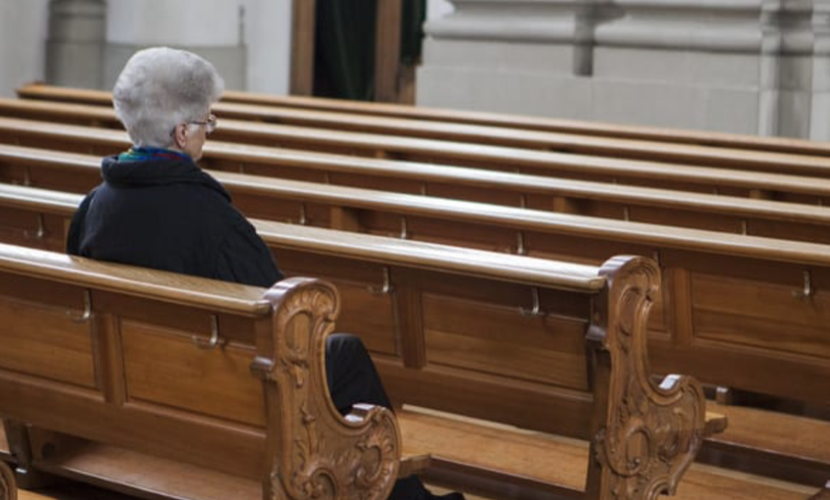Thoughts and prayers pic.twitter.com/KqsKrOVvH2
— Marty Party (@MartyParty65) April 21, 2020
If you read newspapers, the world of coronavirus-era religion appears to be divided into two worlds.
On one side are lots of crazy white evangelicals — you know, the people in MAGA hats — who want to return to face-to-face worship and, thus, risk the lives of ordinary people in their communities. These are the bad guys in this drama.
There have been a few news reports that note that quite a few black Pentecostals are part of this camp, but, well, nevermind. That information just complicates things.
On the other side are the good guys — mainline Protestants and Catholics who have embraced online church life and deserve to be cheered.
Now, where does the following information from Baptist Press — the media arm of the giant Southern Baptist Convention — fit into this picture? This is from a story on initial discussions, among SBC leaders, of reopening the doors of their churches. That’s right — the Southern Baptists (I haven’t heard of any exceptions) have been worshiping online. This is long, but the details matter:
Michael Lewis, pastor of Roswell Street Baptist Church in Marietta, Ga., said his team is cautiously planning to reopen as early as May 10, though the date is tentative and dependent on progress as measured by the official guidelines for reopening set out by the White House Coronavirus Task Force.
Lewis said Marietta, one of Atlanta’s northern suburbs, is almost through the Phase 1 of the COVID-19 guidelines from the Centers for Disease Control and Prevention for reopening states. When the city enters Phase 2, Roswell Street Baptist, which averages about 700 in attendance Sunday morning, would conduct two worship-only services.
Two staff members would monitor two designated entrances. There would be no greeters, but those doors would remain open throughout the services. Attendees would be seated by household, with groups separated by at least six feet. They would be formally seated and dismissed in order to maintain social-distancing. Restroom use would be limited. The church would not print bulletins.
“We’re going to adhere very strictly to the CDC guidelines,” Lewis said, noting that the May 10 target date could be postponed if necessary.
Other pastors outlined similar protocols, even as they’re not sure when they’ll implement them. Micah Fries, pastor of Brainerd Baptist in Chattanooga, Tenn., expects an incremental approach.
Some churches may mix social-distancing worship inside their sanctuaries without drive-in or outdoor services, as the weather warms up.
The key: SBC leaders are stressing the need for social-distancing and cooperating with government leaders.
That’s one side of an emerging landscape of options. However, that piece didn’t take into account a demographic factor that political scientist and progressive Baptist pastor Ryan Burge — a GetReligion partner — stresses in his latest think piece for Christianity Today. The headline:
Churches Should Not Be the First to Reopen
The demographics of many US congregations make sanctuaries a risky place for gatherings to resume.
What’s the key figure in this essay?

That’s easy to spot — the needs of older church members. Evangelicals need to think about this factor, along with leaders of the oldline Protestant flocks:
… Religious demography indicates that, for the sake of the safety of aging congregations in particular, pastors in particular should be cautious. Their sanctuaries are ideal places for the coronavirus to spread, and the results could be catastrophic.
Older churchgoers are bound to be among the most eager to return to services. The elderly were particularly prone to social isolation and loneliness before the pandemic, and during the intervening weeks of social distancing, they were less likely to have participated in the digital options offered as an alternative to in-person fellowship.
But the elder saints who faithfully fill American pews also fall in the demographic shown to be at the greatest risk right now. While scientists still don’t know much about COVID-19, one of the most consistent findings is that the disease carries a much higher fatality rate among older adults. According to data from the Centers for Disease Control and Prevention, 91 percent of all deaths related to the virus have occurred among people 55 or older, though they make up just 29 percent of the population.
Survey data shows more than half (53%) of Christians who attend church at least weekly are 55 or older, compared to 43 percent of the population overall. Mainline traditions in particular skew older, with over 60 percent of members who are at least 55. Half of evangelicals in the US are at least 55, followed by 47.1 percent of Catholics.
This mainline trend is, literally, old news.
Some of the “Seven Sisters” of Protestantism have been caught in death spirals (hello Anglican Church of Canada) for several decades. But there are trends here for evangelical leaders — black and white — to note, as well.
Over the past few decades, white Christianity has aged far more rapidly than the black church and churches of other racial backgrounds.
The average white evangelical was 45 years old in 1972, the same as the average evangelical of color. While there has been no significant net change in the average age for nonwhite evangelicals, white evangelicals have gotten seven years older. …
Though Protestants from historically black denominations skew younger than majority white churches (just 38.3% are 55 or older), their congregations may also be at greater risk. COVID-19 has taken a disproportionate toll on the African American community, and at least a dozen bishops and pastors in the Church of God in Christ (COGIC) have died from the virus.
Lots to think about. Read it all.










